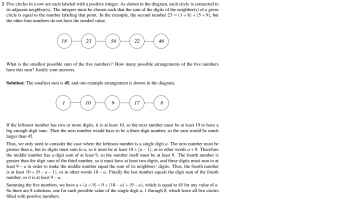Hi,
Need help. Attached is BAMO ( Bay Area Math Olympiad) 2011 Problem 2. I don't know why the answer is 45.
I understand that first number has to be single digit. However, I think below examples also fulfil the requirement that the sum of the digits of the neighbor(s) of a given circle is equal to the number labeling that point.
3 -> 10 ->7 -> 15 -> 8 sum = 44
4 -> 10 -> 6 -> 14-> 8 sum = 42
7 -> 10 -> 3 -> 11 -> 8 sum = 39
also, the question did not mention that positive integers cannot be repetitive. in that case. there are even smaller sum value like below
8 -> 10 -> 2 -> 10 -> 8 sum= 38
however, attached is the official solution from the BAMO website. Can someone help and explain what is wrong in my thought process.
Thanks
Need help. Attached is BAMO ( Bay Area Math Olympiad) 2011 Problem 2. I don't know why the answer is 45.
I understand that first number has to be single digit. However, I think below examples also fulfil the requirement that the sum of the digits of the neighbor(s) of a given circle is equal to the number labeling that point.
3 -> 10 ->7 -> 15 -> 8 sum = 44
4 -> 10 -> 6 -> 14-> 8 sum = 42
7 -> 10 -> 3 -> 11 -> 8 sum = 39
also, the question did not mention that positive integers cannot be repetitive. in that case. there are even smaller sum value like below
8 -> 10 -> 2 -> 10 -> 8 sum= 38
however, attached is the official solution from the BAMO website. Can someone help and explain what is wrong in my thought process.
Thanks

